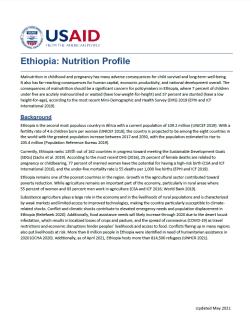Ethiopia is the second most populous country in Africa with a current population of 109.2 million (UNICEF 2019). With a fertility rate of 4.6 children born per woman (UNICEF 2018), the country is projected to be among the eight countries in the world with the greatest population increase between 2017 and 2050, with the population estimated to rise to 205.4 million (Population Reference Bureau 2019).
Currently, Ethiopia ranks 135th out of 162 countries in progress toward meeting the Sustainable Development Goals (SDGs) (Sachs et al. 2019). According to the most recent DHS (2016), 25 percent of female deaths are related to pregnancy or childbearing, 77 percent of married women have the potential for having a high-risk birth (CSA and ICF International 2016), and the under-five mortality rate is 55 deaths per 1,000 live births (EPHI and ICF 2019).
Ethiopia remains one of the poorest countries in the region. Growth in the agricultural sector contributed toward poverty reduction. While agriculture remains an important part of the economy, particularly in rural areas where 55 percent of women and 83 percent men work in agriculture (CSA and ICF 2016; World Bank 2019).
Subsistence agriculture plays a large role in the economy and in the livelihoods of rural populations and is characterized by weak markets and limited access to improved technologies, making the country particularly susceptible to climate-related shocks. Conflict and climatic shocks contribute to elevated emergency needs and population displacement in Ethiopia (Reliefweb 2020). Additionally, food assistance needs will likely increase through 2020 due to the desert locust infestation, which results in localized losses of crops and pasture, and the spread of coronavirus (COVID-19) as travel restrictions and economic disruptions hinder peoples’ livelihoods and access to food. Conflicts flaring up in many regions also put livelihoods at risk. More than 8 million people in Ethiopia were identified in need of humanitarian assistance in 2020 (OCHA 2020). Additionally, as of April 2021, Ethiopia hosts more than 814,500 refugees (UNHCR 2021).

